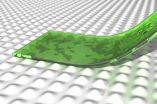(Press-News.org) This news release is available in French.
By looking at 40 different factors in 14 year old teens, including brain structure and function, personality, life experiences and genetics, researchers can predict with 70% accuracy who will go on to develop binge drinking within the next two years. Impulsivity, hopelessness, sensation-seeking traits, lack of conscientiousness, and other variables such as life events and a family history of drug use contribute to the likelihood of binge drinking. Whether or not the child had had a single drink at age 14 was a particularly powerful predictor, the researchers found. Slightly over 40% of North American 13 and 14 year olds have used alcohol, while 10% of Quebec high school students graduate from high school with substance use problems. The study was driven by the IMAGEN consortium, a European research project on risk taking behaviour in teenagers. Patricia Conrod of the University of Montreal and CHU Sainte-Justine Hospital Research Centre designed the original assessment battery and the participant recruitment strategy for the IMAGEN study. She also developed the brief personality scale that was shown to be highly predictive of drinking at 14 and 16 years of age. The first and senior authors of the research article are affiliated with the University of Vermont, University College Dublin, and Trinity College Dublin.
In total, 2,400 European 14 year olds participated in the IMAGEN study. In addition to providing information about their life events, their psychological profile and their substance use, the children underwent an MRI as they played a game (to measure their brains responses to rewards) and were shown angry faces (to measure their emotional reactivity.) The team found that the right middle and precentral gyri and bilateral superior front gyrus areas of the brain were most revealing of the likelihood of future binge drinking. Compared to others, at risk youth had reduced grey matter volume but increased activity in their superior frontal gyrus when receiving a reward. In the premotor cortex, they had more grey matter and greater activity when they failed to inhibit themselves. The MRI results helped validate the factors that the researchers identified as placing a child at risk.
Indeed, the findings do not suggest that binge drinking is hardwired but rather give professionals working with youth ways of finding people in need of help. "The personality dimensions that were shown to be highly predictive of behaviour were assessed using a scale that is currently being used in schools across Montreal to provide targeted prevention to youth at risk of substance misuse," Conrod said. "Early alcohol use strongly predicts adult alcohol dependence, and every year we can delay alcohol use translates to a 10% decrease in the likelihood of alcoholism later. Outreach efforts that correctly target particularly at risk youth can therefore be of lifelong significance and importance to that person."
INFORMATION:
About the study
The article "Neuropsychosocial profiles of current and future adolescent alcohol misusers" was published in Nature on July 2, 2014. The study was funded in part by the European Union-funded FP6 Integrated Project IMAGEN (Reinforcement-related
behaviour in normal brain function and psychopathology) (LSHM-CT- 2007-037286),
the FP7 projects IMAGEMEND (602450; IMAging GEnetics for MENtal Disorders) and
MATRICS (603016), the Innovative Medicine Initiative Project EU-AIMS (115300-2), a
Medical Research Council Programme Grant ''Developmental pathways into
adolescent substance abuse'' (93558), the Swedish funding agency FORMAS, the
Medical Research Council and the Wellcome Trust (Behavioural and Clinical
Neuroscience Institute, University of Cambridge), the National Institute for Health
Research (NIHR) Biomedical Research Centre at South London and Maudsley NHS
Foundation Trust and King's College London, the Bundesministerium für Bildung und
Forschung (BMBF grants 01GS08152; 01EV0711; eMED SysAlc 01ZX1311A;
Forschungsnetz AERIAL), the Deutsche Forschungsgemeinschaft (DFG):
Reinhart-Koselleck Award SP 383/5-1 and grants SM 80/7-1, SFB 940/1, FOR 1617), the French MILDT (Mission Interministérielle de Lutte contre la Drogue et la
Toxicomanie), the CENIR (Centre de NeuroImagerie de Recherche, Pr. S. Lehéricy) within the ICM institute, the National Institute of Mental Health (MH082116), a National
Institutes of Health Center of Biomedical Research Excellence award P20GM103644 from the National Institute of General Medical Sciences and the Tobacco Centers of
Regulatory Science award P50DA036114. The University of Montreal is officially known as Université de Montréal.
What drives a child to abuse alcohol?
Researchers discover a variety of factors that determine, with 70 percent accuracy, which kids will become binge drinkers
2014-07-09
ELSE PRESS RELEASES FROM THIS DATE:
One secret of ancient amber revealed
2014-07-09
The warm beauty of amber was captivating and mysterious enough to inspire myths in ancient times, and even today, some of its secrets remain locked inside the fossilized tree resin. But for the first time, scientists have now solved at least one of its puzzles that had perplexed them for decades. Their report on a key aspect of the gemstone's architecture appears in the ACS journal Analytical Chemistry.
Jennifer Poulin and Kate Helwig of the Canadian Conservation Institute point out that much of the amber we see today had its origins millions of years ago, when it exuded ...
Sunshine vitamin ups bowel cancer survival odds, study finds
2014-07-09
Bowel cancer patients with high levels of vitamin D in their blood are more likely to survive the disease, a study shows.
Patients with the highest levels of vitamin D have half the risk of dying compared with those with the lowest levels, the findings reveal.
The study is the first to correlate total blood levels of vitamin D in bowel cancer patients after their diagnosis – which includes that produced after exposure to sunlight and that obtained from dietary sources – with their long term survival prospects.
The University of Edinburgh team tested blood samples ...
Short circuit in the food web
2014-07-09
Jena (Germany) They are amongst the most numerous inhabitants of the sea: tiny haptophytes of the type Emiliania huxleyi. Not visible to the naked eye, when they are in bloom in spring, they form square kilometer sized patches, they are even visible on satellite images. "Together with other phytoplankton, Emiliania huxleyi is responsible for approximately half of the global photosynthesis output," states Prof. Dr. Georg Pohnert of the Friedrich Schiller University Jena (Germany). In the process the greenhouse gas carbon dioxide – CO2 – is extracted from the atmosphere and ...
Fit for the frontline? New study identifies the hearing requirements of British soldiers
2014-07-09
AUDIO:
The gunshot is a binaural recording using KEMAR, the weapon was an SA80 assault rifle and the microphone is 50m downrange from the firer and approximately 30cm from the bullet...
Click here for more information.
University of Southampton researchers, with assistance from the Ministry of Defence, have conducted the first study to identify the hearing requirements of British soldiers fighting on the frontline.
The study, which provides an important and novel insight into ...
Even geckos can lose their grip
2014-07-09
Not even geckos and spiders can sit upside down forever. Nanophysics makes sure of that. Mechanics researchers at Linköping University have demonstrated this in an article just published in Physical Review E. Knowledge that can be of great industrial benefit.
Geckos and spiders that seem to be able to sit still forever, and walk around upside down have fascinated researchers worldwide for many years. We will soon be able to buy smart new fasteners that hold the same way as the gecko's foot. But the fact is, sooner or later the grip is lost, no matter how little force ...
Frogs have developed rapid defences against the red swamp crayfish
2014-07-09
The common frog is one of the amphibians with the highest distribution in the Iberian Peninsula. It reproduces preferably in permanent areas of water where it comes into contact with the red swamp crayfish, which preys on its larvae. Research carried out by the Spaniard Germán Orizaola from the University of Uppsala (Sweden) confirms that the larvae of these frogs have developed a defensive response to the invasive species. They also have deeper tails and larger bodies if they co-exist with the crayfish.
Numerous invasive organisms are currently spreading outside of their ...
RUB chemists develop novel catalyst with 2 functions
2014-07-09
Chemists at the Ruhr-Universität Bochum have made a decisive step towards more cost-efficient regenerative fuel cells and rechargeable metal-air batteries. They developed a new type of catalyst on the basis of carbon, which can facilitate two opposite reactions: electrolysis of water and combustion of hydrogen with oxygen. A catalyst of this kind might make the storage of wind and solar energy and the manufacture of cost-efficient batteries, for example for electric cars, possible. The team published their report in the "International Edition" of the magazine "Angewandte ...
Rotten egg gas holds key to healthcare therapies
2014-07-09
It may smell of flatulence and have a reputation for being highly toxic, but when used in the right tiny dosage, hydrogen sulfide is now being being found to offer potential health benefits in a range of issues, from diabetes to stroke, heart attacks and dementia. A new compound (AP39), designed and made at the University of Exeter, could hold the key to future therapies, by targeting delivery of very small amounts of the substance to the right (or key) places inside cells.
Scientists in Exeter have already found that the compound protects mitochondria – the "powerhouse" ...
NIH launches Phase I clinical trial of novel drug to treat Clostridium difficile infection
2014-07-09
The National Institute of Allergy and Infectious Diseases (NIAID), part of the National Institutes of Health, has launched an early-stage clinical trial of CRS3123, an investigational oral antibiotic intended to treat Clostridium difficile (C. difficile) infection. CRS3123 (previously known as REP3123) is a narrow-spectrum agent that inhibits C. difficile growth while sparing normal intestinal bacteria.
The Phase I trial will enroll up to 30 healthy men and women ages 18 to 45 in a dose-escalation study to evaluate the investigational drug's safety and tolerability. Quintiles, ...
The impact of big data on health care: Health Affairs' July issue
2014-07-09
Big data can yield big savings, if they are used in the right ways. David W. Bates of the Brigham and Women's Hospital and coauthors analyzed six use cases with strong opportunities for cost savings—high-cost patients; readmissions; triage; decompensation (when a patient's condition worsens); adverse events; and treatment optimization when a disease affects multiple organ systems. They suspect that cost-savings benefits will vary widely, though the current costs associated with all six scenarios will be significant. The authors suggest that using analytics for multiple ...
LAST 30 PRESS RELEASES:
Strategic river sensors could have forewarned of Texas Camp flood disaster
Drone sampling of whale breath reveals first evidence of potentially deadly virus in Arctic
Roman soldiers defending Hadrian’s Wall infected by parasites, study finds
Pinochet’s prisoners were tormented with music but still found solace in it, a new book reveals
Fertility remains high in rural Tanzania despite access to family planning
AI-assisted device can improve autism care access
Kinetic careers
Uncovering how parasitic plants avoid attacking themselves to improve crop resistance
Nanoparticle vaccine strategy could protect against Ebola and other deadly filoviruses
Study finds brain care score can predict risk of stroke across racial groups
Key lung immune cells can intensify allergic reactions
Do hormones explain why women experience more gut pain?
New materials conduct ions in solids as easily as in liquids
Breakthrough of the Year: Renewable energy begins to eclipse fossil fuel-based sources
LLM use is reshaping scientific enterprise by increasing output, reducing quality and more
Introducing LightGen, a chip for ultra-fast, ultra-efficient generative AI
Astronomers see fireworks from violent collisions around nearby star
ACC/AHA issue new guideline on managing congenital heart disease in adults
Cosmic crash caught on camera
Is talented youth nurtured the wrong way? New study shows: top performers develop differently than assumed
Ants: An untapped resource in the development of antibiotics?
Archaeologists use AI to create prehistoric video game
Mitochondria migrate toward the cell membrane in response to high glucose levels
Tiny viral switch offers hope against drug-resistant bacteria
Most parents aware of early peanut introduction guidelines, but confused about details
HPV vaccine can protect against severe lesions of the vulva and vagina
Virtual care provision and emergency department use among children and youth
Quadrivalent HPV vaccine and high-grade vulvovaginal lesions
Insights into dry eyes gained from stem cell-derived tear glands
Researchers identify 166 human pluripotent stem cell lines available for use in clinical applications
[Press-News.org] What drives a child to abuse alcohol?Researchers discover a variety of factors that determine, with 70 percent accuracy, which kids will become binge drinkers



